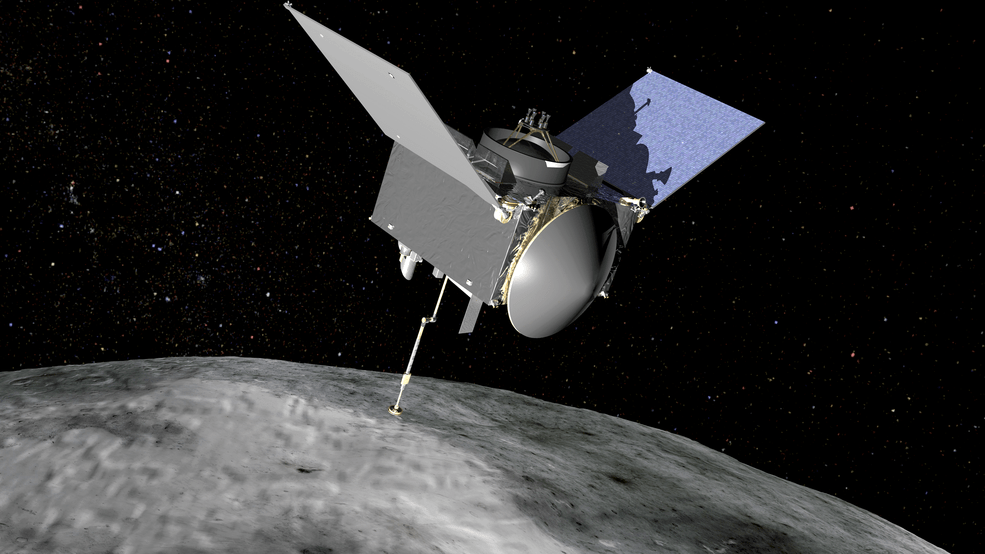Pictured: A United Launch Alliance Atlas V rocket first stage booster is lifted into position at Space Launch Complex 41, located at Cape Canaveral Air Force Station in Florida on Aug. 8. The Centaur upper stage was hoisted atop the booster today.
The vehicle will boost NASA’s Origins, Spectral Interpretation, Resource Identification, Security-Regolith Explorer, or OSIRIS-REx spacecraft. Targeted for liftoff Sept. 8, 2016, OSIRIS-Rex will be the first U.S. mission to sample an asteroid, retrieve at least two ounces of surface material and return it to Earth for study. The asteroid, Bennu, may hold clues to the origin of the solar system and the source of water and organic molecules found on Earth.
Photo credits: NASA/Glenn Benson
Quelle: NASA
---
NASA is preparing to launch its first mission to return a sample of an asteroid to Earth. The mission will help scientists investigate how planets formed and how life began, as well as improve our understanding of asteroids that could impact Earth.
The Origins, Spectral Interpretation, Resource Identification, Security-Regolith Explorer (OSIRIS-REx) spacecraft will travel to the near-Earth asteroid Bennu and bring a sample back to Earth for intensive study. Launch is scheduled for 7:05 p.m. EDT Thursday, Sept. 8 from Cape Canaveral Air Force Station in Florida.
“This mission exemplifies our nation’s quest to boldly go and study our solar system and beyond to better understand the universe and our place in it,” said Geoff Yoder, acting associate administrator for the agency’s Science Mission Directorate in Washington. “NASA science is the greatest engine of scientific discovery on the planet and OSIRIS-REx embodies our directorate’s goal to innovate, explore, discover, and inspire.”
The 4,650-pound (2,110-kilogram) fully-fueled spacecraft will launch aboard an Atlas V 411 rocket during a 34-day launch period that begins Sept. 8, and reach its asteroid target in 2018. After a careful survey of Bennu to characterize the asteroid and locate the most promising sample sites, OSIRIS-REx will collect between 2 and 70 ounces (about 60 to 2,000 grams) of surface material with its robotic arm and return the sample to Earth via a detachable capsule in 2023.
"The launch of OSIRIS-REx is the beginning a seven-year journey to return pristine samples from asteroid Bennu," said OSIRIS-REx Principal Investigator Dante Lauretta of the University of Arizona, Tucson. "The team has built an amazing spacecraft, and we are well-equipped to investigate Bennu and return with our scientific treasure."
OSIRIS-REx has five instruments to explore Bennu:
- OSIRIS-REx Camera Suite (OCAMS) – A system consisting of three cameras provided by the University of Arizona, Tucson, will observe Bennu and provide global imaging, sample site imaging, and will witness the sampling event.
- OSIRIS-REx Laser Altimeter (OLA) – A scanning LIDAR (Light Detection and Ranging) contributed by the Canadian Space Agency will be used to measure the distance between the spacecraft and Bennu's surface, and will map the shape of the asteroid.
- OSIRIS-REx Thermal Emission Spectrometer (OTES) – An instrument provided by Arizona State University in Tempe that will investigate mineral abundances and provide temperature information with observations in the thermal infrared spectrum.
- OSIRIS-REx Visible and Infrared Spectrometer (OVIRS) – An instrument provided by NASA’s Goddard Space Flight Center in Greenbelt, Maryland and designed to measure visible and infrared light from Bennu to identify mineral and organic material.
- Regolith X-ray Imaging Spectrometer (REXIS) – A student experiment provided by the Massachusetts Institute of Technology (MIT) and Harvard University in Cambridge, which will observe the X-ray spectrum to identify chemical elements on Bennu’s surface and their abundances.
Additionally, the spacecraft has two systems that will enable the sample collection and return:
- Touch-And-Go Sample Acquisition Mechanism (TAGSAM) – An articulated robotic arm with a sampler head, provided by Lockheed Martin Space Systems in Denver, to collect a sample of Bennu's surface.
- OSIRIS-REx Sample Return Capsule (SRC) – A capsule with a heat shield and parachutes in which the spacecraft will return the asteroid sample to Earth, provided by Lockheed Martin.
"Our upcoming launch is the culmination of a tremendous amount of effort from an extremely dedicated team of scientists, engineers, technicians, finance and support personnel," said OSIRIS-REx Project Manager Mike Donnelly at Goddard. "I'm incredibly proud of this team and look forward to launching the mission's journey to Bennu and back."
Goddard provides overall mission management, systems engineering, and safety and mission assurance for OSIRIS-REx. Lockheed Martin Space Systems built the spacecraft. Dante Lauretta of the University of Arizona, Tucson, is the principal investigator. OSIRIS-REx is the third mission in NASA's New Frontiers Program. NASA's Marshall Space Flight Center in Huntsville, Alabama, manages New Frontiers for the agency's Science Mission Directorate in Washington.
Quelle: NASA
---
How do you study the topography of an asteroid millions of miles away? Map it with a robotic cartographer!
NASA’s Origins, Spectral Interpretation, Resource Identification, Security-Regolith Explorer, or OSIRIS-REx, will launch in September 2016 and travel to a near-Earth asteroid known as Bennu to harvest a sample of surface material and return it to Earth for study. But before the science team can select a sample site, it needs to know a little something about the asteroid’s topography.
The OSIRIS-REx Laser Altimeter, or OLA, is provided by the Canadian Space Agency and will be used to create three-dimensional global topographic maps of Bennu and local maps of candidate sample sites.
Think of your favorite computer animated movie. The characters and environment are colored and shaded in such a way that they look almost lifelike. But all of those details need a 3-D shape in order to take form. The same is true for the detailed data gathered by OSIRIS-REx’s instruments.
To create these 3-D models, OLA uses LIDAR, which stands for light detection and ranging. LIDAR is similar to radar, but uses light instead of radio waves to measure distance. OLA will emit infrared laser pulses toward the surface of Bennu as the spacecraft moves around the asteroid. The laser pulses reflect back from the surface to a detector. The team will measure the time difference between outgoing and incoming pulses to calculate the distance between the spacecraft and Bennu.
LIDAR has been used on prior spacecraft, including the Mars Global Surveyor and the Lunar Reconnaissance Orbiter. Those laser altimeters are fixed to the spacecraft, meaning that the laser pulse will only travel in the direction that the spacecraft is pointing. This can limit the coverage and spatial resolution of their topographic maps. So, while they have generated a vast amount of data, fixed LIDAR are not ideal for missions where the data must be gathered quickly.
"OLA is the first scanning LIDAR to fly on a planetary mission," said Beau Bierhaus, an OLA team member at Lockheed Martin. "Because the LIDAR can articulate independently of the spacecraft, the LIDAR provides improved operational flexibility, and more importantly, much greater spatial coverage and resolution."
OLA is expected to thoroughly map Bennu with about 6 billion measurements of the asteroid’s surface, which measures about one-third of a mile (one-half kilometer) in diameter. In comparison, the laser altimeter on the Lunar Reconnaissance Orbiter has received more than 6.8 billion measurements of the surface of the moon, which has a diameter of about 2,159 miles (3,500 kilometers).
The fundamental data of the asteroid’s shape and topography that OLA will provide are essential for several key phases during the mission.
The science team will use the high-resolution topographic data, in conjunction with camera images and on-board navigation algorithms, to navigate around the asteroid and guide the spacecraft to the selected sample site.
“We’re measuring topography down to one centimeter,” said Olivier Barnouin, the Altimetry Working Group lead at Johns Hopkins University Applied Physics Laboratory in Laurel, Maryland. “We’re looking at an asteroid at a scale that no other mission has before. We don’t want to be off in some unknown area during sample acquisition.”
The three-dimensional maps will also give geologic context to the returned asteroid sample. Just as geologists on Earth document where they collect their samples in the field on topographic maps, OLA will allow the science team to take their measurements and observations of the collected sample and apply them to their broader understanding of Bennu.
OLA will also allow the science team to study how regolith, or loose surface material, behaves in a microgravity environment. Scientists have done similar studies on the moon and Mars, but unlike Bennu, these bodies have relatively high gravity.
“What happens on asteroids is that you take that gravity dial and turn it way down,” Bierhaus said. “The dynamics of how regolith moves on the surface of the asteroid are foreign to us. OLA data will give us a greater understanding of how granular material behaves in space.”
This understanding is especially important for future asteroid missions. Scientists will need to know how regolith behaves in micro-gravity environments if we want to send astronauts to an asteroid someday to collect samples.
“Collaborating on this project reminds us of the unique relationship between Canada and the United States,” said Daly. “It provides both countries access to additional technological expertise and people that they would not otherwise have.”
Goddard will provide overall mission management, systems engineering and safety and mission assurance for OSIRIS-REx. Dante Lauretta is the mission’s principal investigator at the University of Arizona. Lockheed Martin Space Systems in Denver built the spacecraft. OSIRIS-REx is the third mission in NASA’s New Frontiers Program. NASA’s Marshall Space Flight Center in Huntsville, Alabama, manages New Frontiers for the agency’s Science Mission Directorate in Washington.
Quelle: NASA
-
Update: 28.08.2016
.
Nearly There: NASA’s OSIRIS-REx Being Readied for Sept. 8 Launch
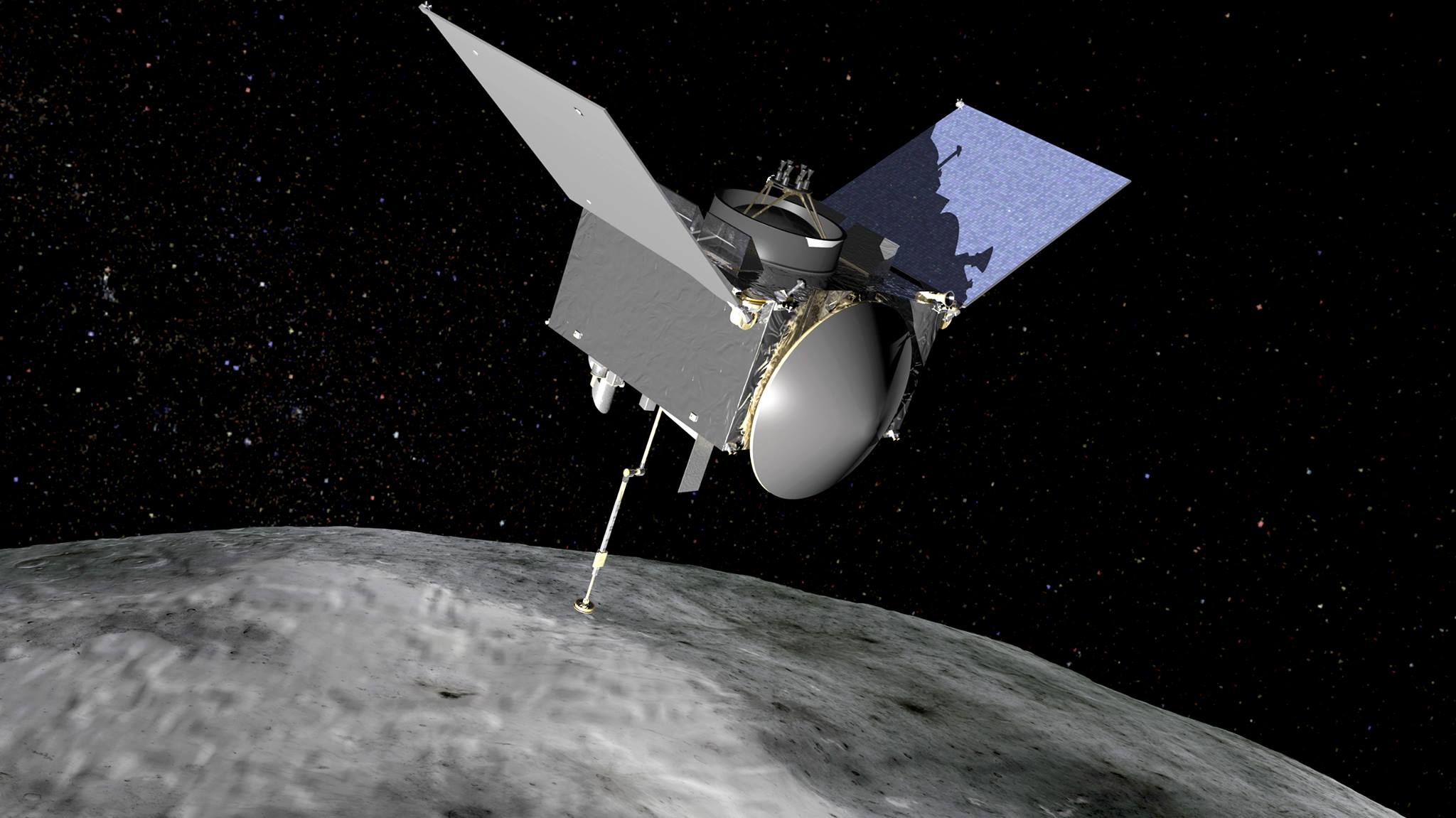
An artist’s rendering of OSIRIS-REx at asteroid 101955 Bennu. Image Credit: NASA
The last decade has proven to be watershed years for deep space exploration. While the European Space Agency’s Rosetta spacecraft proved a small lander could be set down upon a rocky comet, other missions including NASA’s Curiosity rover, Dawn, and New Horizons showed that humanity could explore both known and strange new foreign worlds. Most recently, the space agency’s Juno spacecraft entered Jupiter’s orbit on July 4, and is set to return data and images illuminating the origins of our Solar System.
Continuing the past few years’ breakthroughs, the third spacecraft in NASA’s New Frontiers Program (behind New Horizons and Juno), called the Origins, Spectral Interpretation, Resource Identification, Security, Regolith Explorer (better known as OSIRIS-REx), is less than two weeks from its scheduled launch date. The spacecraft and launch vehicle both continue to be readied as NASA gears up for yet another pioneering deep space mission. This mission will serve to be NASA’s first asteroid sample return mission in its history.
Spacecraft, Launch Vehicle Coming Together For Sept. 8 Liftoff
OSIRIS-REx’s launch window is currently between 7:05-9:05 p.m. EDT on Thursday, Sept. 8; the launch will take place from Cape Canaveral Air Force Station’s Launch Complex 41. The spacecraft will take flight aboard a United Launch Alliance (ULA) Atlas V 411 rocket. At present, several key milestones are taking place prior to the rocket being fully ready for liftoff en route to complete an ambitious exploration and sample return mission at the asteroid 101955 Bennu. If for some reason the launch is scrubbed on Sept. 8, the launch window will remain open for a period of 34 days, through Oct. 12.
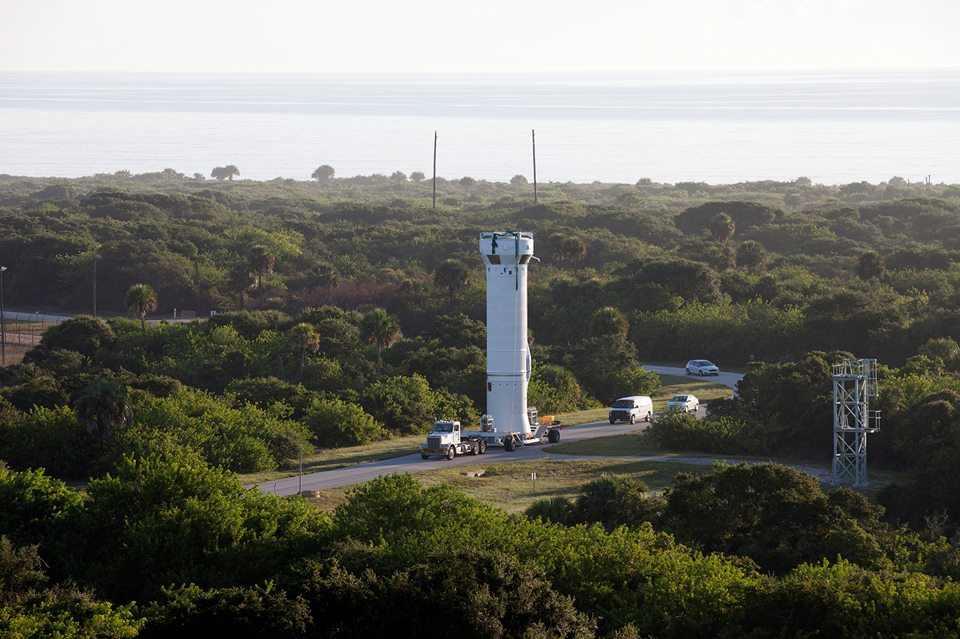
The Atlas V 411’s Centaur stage on its way to be stacked. Photo Credit: The OSIRIS-REx Facebook page, NASA
Earlier this month, the ULA rocket that will deliver OSIRIS-REx to the heavens was transported by barge to NASA’s Kennedy Space Center (KSC) to be prepared for its contribution to the mission. The Atlas’ solid rocket booster and first stage were assembled at KSC’s Vertical Integration Facility. According to ULA, the 411 configuration “adds a single strap-on booster rocket to the first stage.”
However, these elements won’t be able to provide enough firepower to get OSIRIS-REx to its target. The spacecraft will need a boost from a high-energy upper stage as it makes its way into space, and that’s where the Centaur upper stage comes in. On Aug. 24, it was announced the Centaur was installed on the rocket. On Aug. 25 the Centaur underwent a wet, fueled dress rehearsal (this stage utilizes liquid hydrogen and oxygen) in preparation for its launch in less than two weeks.
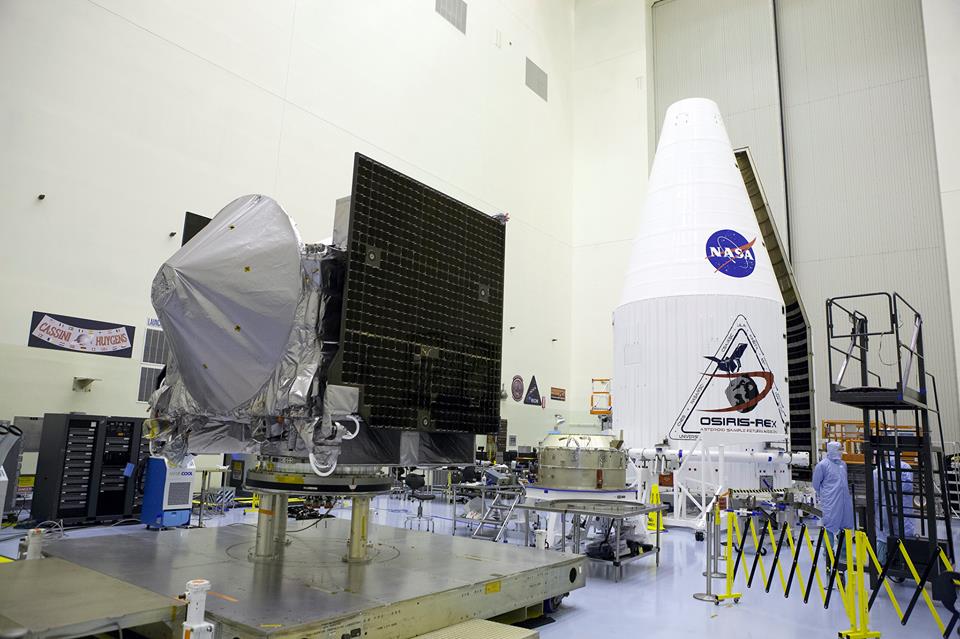
OSIRIS-REx alongside its payload fairing. Photo Credit: The OSIRIS-REx Facebook page, NASA
The spacecraft is currently being encapsulated in its four-meter-wide payload fairing at the Payload Hazardous Service Facility at KSC prior to it being integrated with the launch vehicle. Other tests were performed concerning the spacecraft itself as launch time loomed ahead. Mike Donnelly, OSIRIS-REx’s project manager at NASA’s Goddard Space Flight Center in Greenbelt, Md., reported, “We have done a spin balance test, we took the solar arrays off and cleaned them, put them back on, filled the tanks with fuel, and installed all the thermal protective blankets on the spacecraft.” The spacecraft’s solar panels were also unfolded and folded back to ensure they work flawlessly. On Monday, Aug. 29, the spacecraft is scheduled to be mounted on top of its rocket.
After the OSIRIS-REx is fully integrated with its Atlas V, and all is said and done pre-launch, the launch vehicle will utilize its 860,000 mighty pounds of thrust to send the intrepid spacecraft to its destination, a never-before-explored asteroid.
What Makes OSIRIS-REx Different
The newest addition to the New Frontiers Program will orbit an asteroid, get a closer look, and then swoop in for a valuable sample. While NASA’s Stardust spacecraft returned dust from the tail of comet Wild 2 in 2004, the space agency has never before attempted to return a sample from an asteroid. OSIRIS-REx will utilize a long “arm” called the Touch-and-Go Sample Acquisition Mechanism—TAGSAM for short—to aid in bringing its treasure home to Earth via a return capsule. According to the University of Arizona’s Lunar and Planetary Laboratory(which developed the mission along with NASA’s Goddard Space Flight Center and Lockheed Martin Space Systems), in tests the TAGSAM system collected an average of 300 grams of materials, more than five times the minimum sample return mandated by NASA.
Why visit an asteroid? This mission seeks to understand further how our Solar System was formed. NASA’s Jim Green, director of the agency’s Planetary Science Division, emphasized, “One of the amazing things about OSIRIS-REx is that it addresses all of the science goals that planetary science has at NASA: how the solar system works, how it formed, how it informs our understanding of life in solar system and elsewhere, and how we can understand the resources and hazards of asteroids and better characterize those.” In learning more about an asteroid, humanity can learn more about its origins.
While meteorites have been found frequently on Earth, these may contain contaminants and are not “pure” samples of deep space. OSIRIS-REx will give scientists and researchers the opportunity to study particles and material directly from the source. And on Thursday, Sept. 8, it will, at long last, begin its long, strange trip.
Be sure to follow OSIRIS-REx’s launch on AmericaSpace’s launch tracker during the evening of Thursday, Sept. 8.
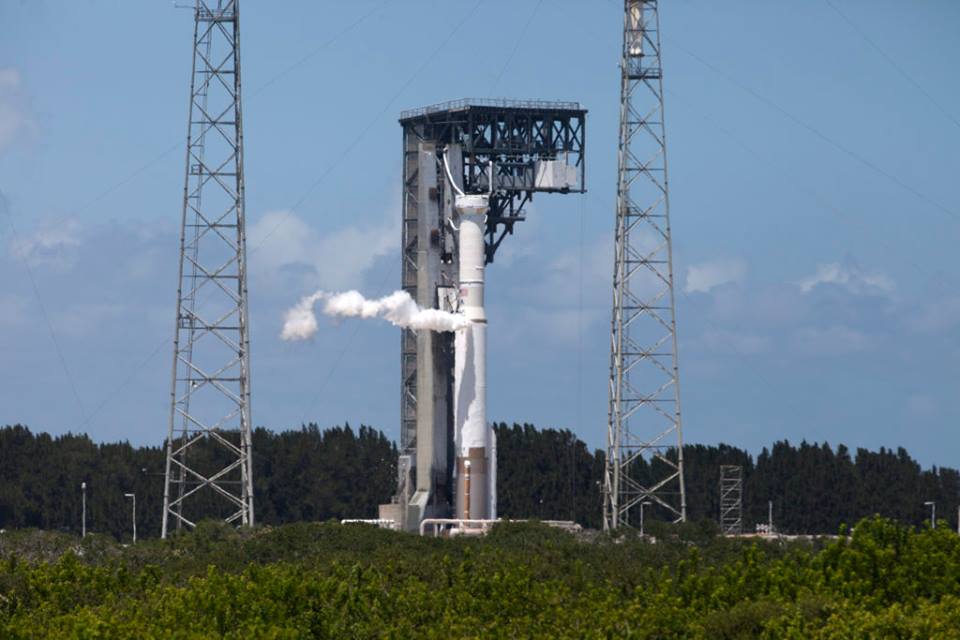
The Centaur stage undergoes a wet, fueled test. In less than two weeks, this rocket stage will help carry OSIRIS-REx to deep space. Photo Credit: The OSIRIS-REx Facebook page, NASA
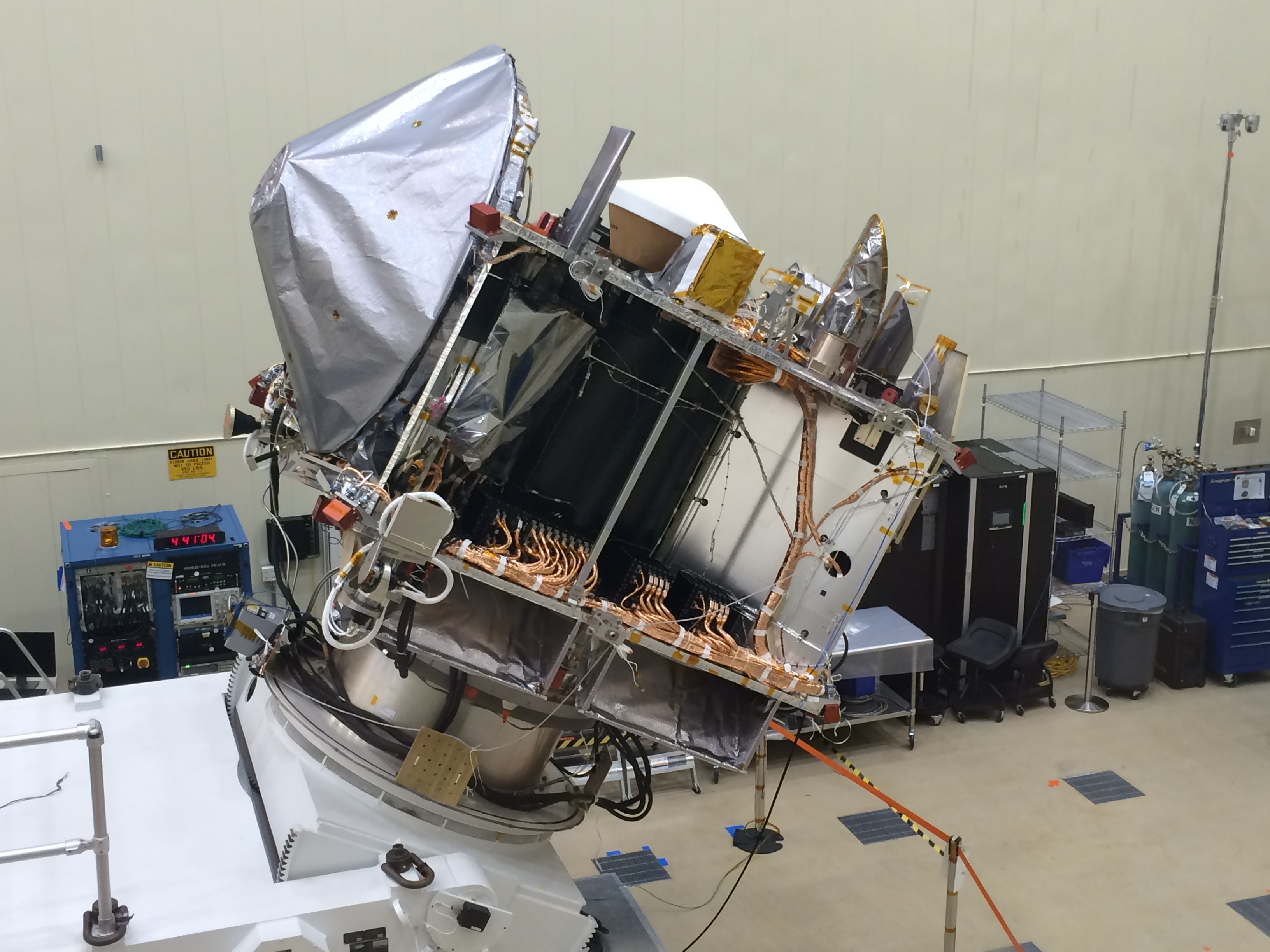
From the University of Arizona: “OSIRIS-REx in the clean room at Lockheed Martin in April 2016 after testing was completed and the TAGSAM arm was stowed for the final time.” Photo Credit: University of Arizona/Christine Hoekenga
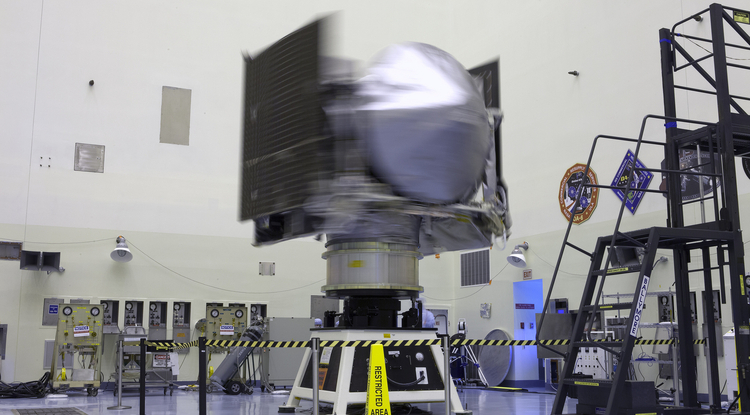
From NASA: “NASA’s OSIRIS-REx spacecraft rotates on a spin table during a weight and center of gravity test inside the Payload Hazardous Servicing Facility at Kennedy Space Center in Florida. The spacecraft is being prepared for its scheduled launch on Sept. 8.” The spacecraft underwent a series of last-minute tests to ensure it was 100% ready for the rigors of deep space. Photo Credit: NASA/Kim Shiflett
Quelle: AS
-
Update: 30.08.2016
-
NASA’S OSIRIS-REX ASTEROID SAMPLING PROBE ASSEMBLED AT FLORIDA LAUNCH BASE FOR SEP. 8 BLASTOFF — CLEANROOM PHOTOS
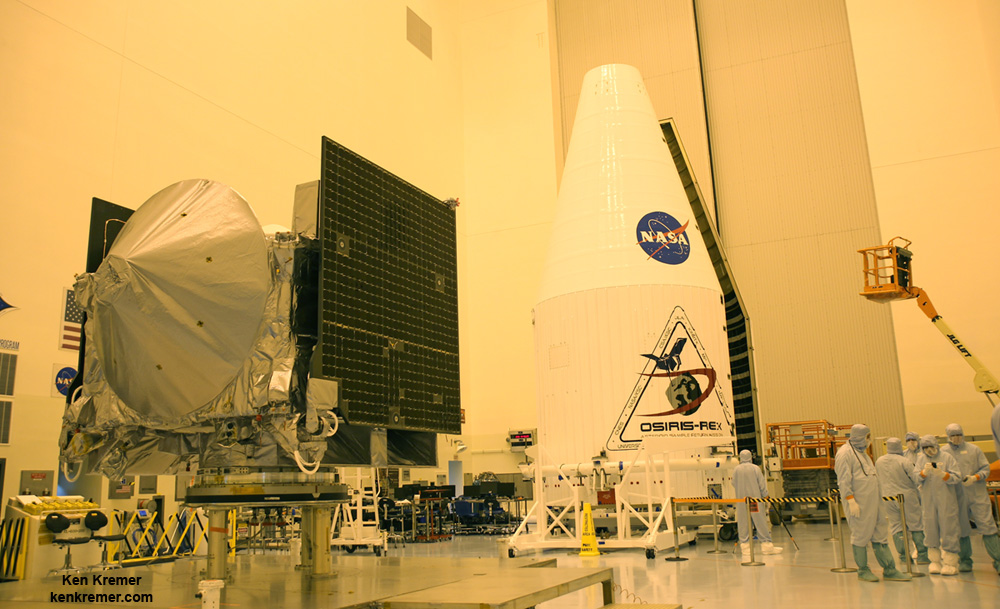
NASA’s OSIRIS-REx asteroid sampling spacecraft, return capsule and payload fairings inside the Payloads Hazardous Servicing Facility high bay at NASA’s Kennedy Space Center is being processed for Sep. 8, 2016 launch to asteroid Bennu from Cape Canaveral, FL. Credit: Ken Kremer/kenkremer.com
KENNEDY SPACE CENTER, FL – OSIRIS-Rex, the first American sponsored probe aimed at retrieving “pristine materials” from the surface of an asteroid and returning them to Earth has been fully assembled at its Florida launch base and is ready to blastoff ten days from today on Sep. 8. It’s a groundbreaking mission that could inform us about astrobiology and the ‘Origin of Life.’
“We are interested in that material because it is a time capsule from the earliest stages of solar system formation,” said Dante Lauretta, principal investigator for OSIRIS-REx at the University of Arizona, Tucson, in an interview with Universe Today beside the completed spacecraft inside the Payloads Hazardous Servicing Facility, or PHSF, clean room processing facility at NASA’s Kennedy Space Center in Florida.
With virtually all prelaunch processing complete, leading members of the science, engineering and launch team including Lauretta met with several members of the media, including Universe Today, inside the clean room for a last and exclusive up-close look and briefing with the one-of-its-kind $800 million Asteroid sampling probe last week.
NASA’s Origins, Spectral Interpretation, Resource Identification, Security – Regolith Explorer (OSIRIS-REx) spacecraft will launch from Space Launch Complex 41 at Cape Canaveral Air Force Station on a United Launch Alliance Atlas V rocket on September 8 at 7:05 p.m. EDT.
OSIRIS-REx goal is to fly on a roundtrip seven-year journey to the near-Earth asteroid target named Bennu and back. Bennu is a near Earth asteroid and was selected specifically because it is a carbon-rich asteroid.
While orbiting Bennu it will move in close and snatch pristine soil samples containing organic materials from the surface using the TAGSAM collection dish, and bring them back to Earth for study by researchers using all of the most sophisticated science instruments available to humankind.
“The primary objective of the OSIRIS-Rex mission is to bring back pristine material from the surface of the carbonaceous asteroid Bennu, OSIRIS-Rex Principal Investigator Dante Lauretta told Universe Today in the PHSF, as the probe was undergoing final preparation for shipment to the launch pad.
“It records the very first material that formed from the earliest stages of solar system formation. And we are really interested in the evolution of carbon during that phase. Particularly the key prebiotic molecules like amino acids, nucleic acids, phosphates and sugars that build up. These are basically the biomolecules for all of life.”
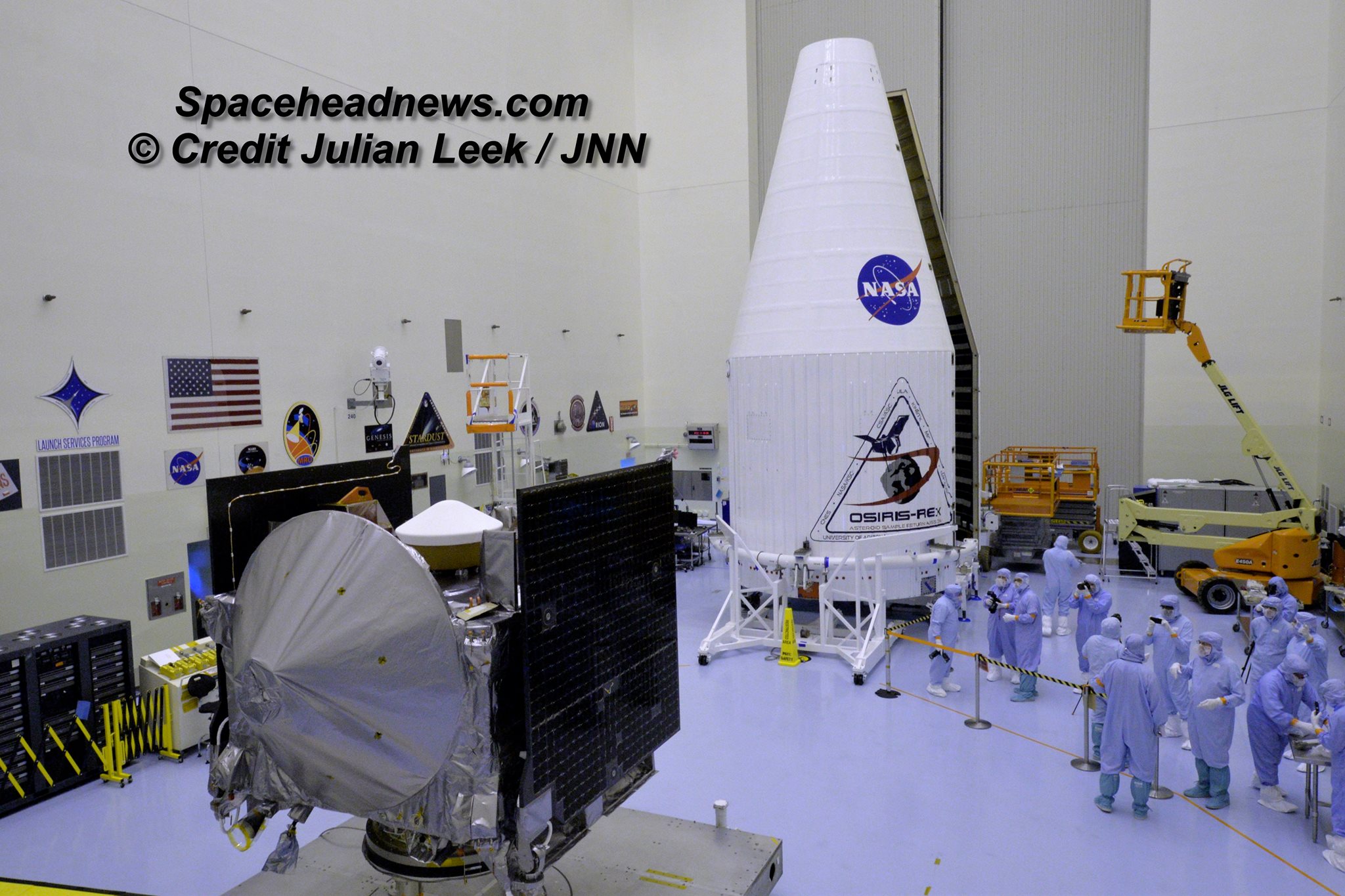
Overhead view of NASA’s OSIRIS-REx asteroid sampling spacecraft with small white colored sample return canister atop, inside the Payloads Hazardous Servicing Facility high bay at NASA’s Kennedy Space Center. Launch is slated for Sep. 8, 2016 to asteroid Bennu from Cape Canaveral Air Force Station, FL. Credit: Julian Leek
OSIRIS-REx will gather rocks and soil and bring at least a 60-gram (2.1-ounce) sample back to Earth in 2023. It has the capacity to scoop up to about 1 kg or more.
The mission will help scientists investigate how planets formed and how life began. It will also improve our understanding of asteroids that could impact Earth by measuring the Yarkovsky effect.
I asked Lauretta to explain in more detail why was Bennu selected as the target to answer fundamental questions related to the origin of life?
“We selected asteroid Bennu as the target for this mission because we feel it has the best chance of containing those pristine organic compounds from the early stage of solar system formation,” Lauretta told me.
“And that information is based on our ground based spectral characterization using telescopes here on Earth. Also, space based assets like the Hubble Space Telescope and the Spitzer Space Telescope.”
What is known about the presence of nitrogen containing compounds like amino acids and other elements on Bennu that are the building blocks of life?
“When we look at the compounds that make up these organic materials in these primitive asteroidal materials, we see a lot of carbon,” Lauretta explained.
“But we also see nitrogen, oxygen, hydrogen, sulfur and phosphorous. We call those the CHONPS. Those are the six elements we really focus on when we look at astrobiology and prebiotic chemistry and how those got into the origin of life.”

View of science instrument suite and TAGSAM robotic sample return arm on NASA’s OSIRIS-REx asteroid sampling spacecraft inside the Payloads Hazardous Servicing Facility at NASA’s Kennedy Space Center. Probe is slated for Sep. 8, 2016 launch to asteroid Bennu from Cape Canaveral Air Force Station, FL. Credit: Ken Kremer/kenkremer.com
The OSIRIS-REx spacecraft was built for NASA by prime contractor Lockheed Martin at their facility near Denver, Colorado and flown to the Kennedy Space Center on May 20.
For the past three months it has undergone final integration, processing and testing inside the PHSF under extremely strict contamination control protocols to prevent contamination by particle, aerosols and most importantly organic residues like amino acids that could confuse researchers seeking to discover those very materials in the regolith samples gathered for return to Earth.
The PHFS clean room was most recently used to process the Orbital ATK Cygnus space station resupply vehicles. It has also processed NASA interplanetary probes such as the Curiosity Mars Science Laboratory and MAVEN Mars orbiter missions.

Side view of NASA’s OSIRIS-REx asteroid sampling spacecraft showing the High Gain Antenna at left and solar panel, inside the Payloads Hazardous Servicing Facility high bay at NASA’s Kennedy Space Center. Probe is being processed for Sep. 8, 2016 launch to asteroid Bennu from Cape Canaveral Air Force Station, FL. Credit: Ken Kremer/kenkremer.com
The spacecraft will reach Bennu in 2018. Once within three miles (5 km) of the asteroid, the spacecraft will begin at least six months of comprehensive surface mapping of the carbonaceous asteroid, according to Heather Enos, deputy principal investigator, in an interview with Universe Today.
“We will then move the spacecraft to within about a half kilometer or so to collect further data,” Enos elaborated.
It will map the chemistry and mineralogy of the primitive carbonaceous asteroid. The team will initially select about 10 target areas for further scrutiny as the sampling target. This will be whittled down to two, a primary and backup, Enos told me.
After analyzing the data returned, the science team then will select a site where the spacecraft’s robotic sampling arm will grab a sample of regolith and rocks. The regolith may record the earliest history of our solar system.
Engineers will command the spacecraft to gradually move on closer to the chosen sample site, and then extend the arm to snatch the pristine samples the TAGSAM sample return arm.
PI Lauretta will make the final decision on when and which site to grab the sample from.
“As the Principal Investigator for the mission I have responsibility for all of the key decisions during our operations,” Lauretta replied. “So we will be deciding on where we want to target our high resolution investigations for sample site evaluation. And ultimately what is the one location we want to send the spacecraft down to the surface of the asteroid to and collect that sample.”
“And then we have to decide like if we collected enough sample and are we ready to stow it in the sample return capsule. Or are we going to use one of our 2 contingency bottles of gas to go for a second attempt.”
“The primary objective is one successful sampling event. So when we collect 60 grams or 2 ounces of sample then we are done!”
“In the event that we decide to collect more, it will be intermixed with anything we collected on the first attempt.”
The priceless sample will then be stowed in the on board sample return capsule for the long journey back to Earth.

NASA’s OSIRIS-Rex asteroid sampling spacecraft inside the Payloads Hazardous Servicing Facility high bay at NASA’s Kennedy Space Center. Launch is slated for Sep. 8, 2016 to asteroid Bennu from Cape Canaveral Air Force Station, FL. Credit: Lane Hermann
Bennu is an unchanged remnant from the collapse of the solar nebula and birth of our solar system some 4.5 billion years ago, little altered over time.
Bennu is a near-Earth asteroid and was selected for the sample return mission because it could hold clues to the origin of the solar system and host organic molecules that may have seeded life on Earth.
OSIRIS-REx will return the largest sample from space since the American and Soviet Union’s moon landing missions of the 1970s.
Quelle: UT










